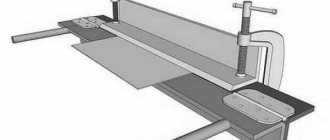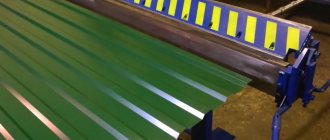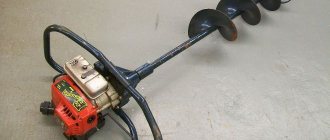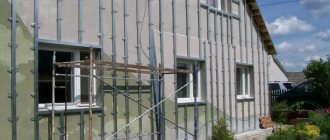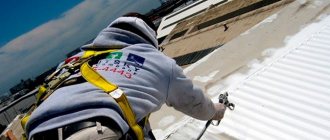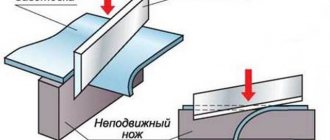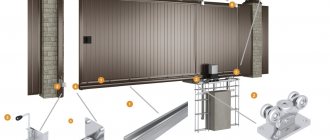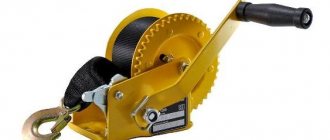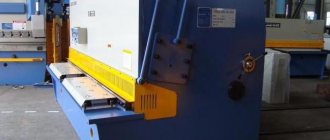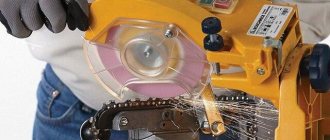Corrugated sheeting, corrugated sheet, profiled sheet - all these are names of the same material used in construction as wall and roof coverings, as well as in the construction of fences and other enclosing structures. Inexpensive, durable, it is a steel sheet with a ribbed surface, galvanized or painted with powder-polymer paint.
The ribbed surface is made to create stiffening ribs, which increases the strength of the material and its ability to withstand significant wind and other mechanical loads. The length and width of the profiled sheet depends on the brand and type of product. The thickness is 0.45-1.2 mm depending on the purpose. Thus, wall corrugated sheeting is thicker than roofing sheeting due to the requirements for its operation.
The advantage of the material is its low cost, determined by the low cost of production. Thanks to this criterion, it is so in demand.
Stages of production of profiled sheets
Wondering how wall and roofing sheeting is made? The production of corrugated sheets is not difficult. The sheet manufacturing technology involves rolling rolled sheet steel with a pre-applied galvanization or polymer coating. Profiling (creating stiffeners) is carried out in one of two basic ways:
- Simultaneously. The workpiece is rolled through a machine, which bends all the specified stiffeners in it at once.
- Consistently. The machine bends only one or several ribs in one pass.
Equipment of the first type allows you to get a much better result and significantly reduces production time. Machines for sequential rolling are cheaper, so they are purchased by small workshops or individual entrepreneurs with limited funds.
The entire line for the production of corrugated sheets is:
- Unwinder. A device for capturing and feeding a blank sheet from a roll.
- Cold rolling machine. Creates stiffeners with specified dimensional parameters.
- Cutting machine. Most often these are hydraulically driven guillotine shears. The roll is cut into finished profiled sheets.
- Receiver. A device for receiving and storing finished materials.
This is a typical production line. Depending on the characteristics of the technologies and equipment used, its composition may vary.
The production process itself is as follows:
- A roll of galvanized or painted steel sheet is unloaded onto the unwinder, where it is fixed in a given position.
- The end of the sheet is fed into the receiver of the rolling machine.
- The operator sets the parameters of the rolling speed, the characteristics of the stiffeners, and the required number of units of corrugated sheeting.
- The equipment starts up and the production process begins.
Modern lines for the production of profiled sheets are automated systems in which all machines are connected into a single technological chain by a common control system. This ensures quality and speed of the process. The number of workers involved in production is also minimized. The result is the lowest possible cost of the finished material, which consists of the costs of the steel sheet, its painting or galvanizing, and the manufacturing itself. Moreover, the share of the last parameter in the formation of the final price by the manufacturer is, as a rule, quite insignificant.
Slicing and packaging
Lastly, the sheets are cut to the required length. All dimensions of corrugated sheets depend on the type of profile; the required length of sheets is indicated by the customer.
Our equipment allows us to make sheets of any size in the range from 0.5 to 12 meters.
Modern high-precision equipment allows us to eliminate the “human factor” from production. All necessary parameters for the manufacture of the product are set by the operator in the automatic control system. Highly qualified personnel work in the workshops for the production of corrugated sheets.
The quality of finished products is controlled by quality control department. Before production begins and at the end of the finished product, samples are taken. The input section operator (using electric scissors) takes a sample from the first roll of a new batch and passes it to the quality control inspector. Quality control is also carried out according to GOST.
Modern equipment allows us to eliminate the “human factor” from production.
The finished corrugated sheet is placed on pallets, covered with bubble wrap and secured with metal ties.
After packaging, orders are placed in a warehouse, from where they are then sent to the end consumer.
Corrugated sheets are well suited for roofs, facades and fences.
Unwinder
Its purpose is to prepare and feed the sheet into the rolling mill, gradually unwinding the roll. As a rule, this device is hydraulically driven, although other systems are also found. Its operation is controlled using a general automated system that coordinates the work of the entire technological chain. The equipment is quite simple. It is based on a gripping and fixing device, a movable shaft, a drive and a braking system for regulating the sheet feed speed.
Rolling mill
A rolling mill (alternatively called a forming machine) is a key machine in any corrugated sheet production line. It is he who turns an ordinary steel strip into a profiled sheet, bending it so as to create stiffeners with the specified characteristics of height, width and distance between them. The technology is simple - cold rolling under high mechanical pressure through a roller system. The drive can be hydraulic, pneumatic or electric.
The rolling mill can be extremely simple, unregulated or minimally regulated. Or complex, allowing you to set a variety of parameters in terms of the number, height and width of bends. The overall quality of the result is determined by the rollers, or more precisely, by their ability to bend the sheet carefully, without deforming it, and without damaging the applied layer of anti-corrosion protection - galvanization or paint.
The most effective are pneumatic machines that are capable of processing steel sheets up to 2500 mm wide, setting the edge angle to 90 degrees. The maximum sheet thickness that such equipment can handle is 1.5 mm.
Briefly about the use of corrugated sheets, delivery from the factory
Profiled sheet C8 is traditionally considered a facade brand (wall, for fences). It is characterized by the lowest profile height and the same size of a uniform trapezoid on both sides of the sheet. C10 corrugated sheeting is also more of a wall material, but with a different trapezoid shape. In some cases, it can also be used as a roofing covering. However, profiled sheet C10 cannot be mounted on large slopes with low roof slopes. Galvanized corrugated sheets C8 and C10 have the lightest weight and therefore installation of even long sheets is quite simple and quick. You can order C8 corrugated sheets of two meter lengths from the warehouse at the factory - these are warehouse items. Other lengths are produced in production within 2-5 days.
Profiled sheet C20 is the most popular roofing brand, used both in industrial construction and in low-rise cottage construction. This material, with a profile height of 18 mm, has sufficient stiffening ribs while simultaneously ensuring good water drainage from the roof. It is possible to use corrugated sheet C20 for a more universal purpose - both on the roof and as a wall material. Roofing profiled sheet C21 is no less popular brand today. The dimensions of a higher profile of 21 mm and a wide selection of metal thicknesses make it possible to effectively use it on the roofs of industrial and public buildings of large areas. However, unlike profiled sheets NS35 or NS44, it does not have load-bearing functions even at maximum thickness.
NS35 corrugated sheeting is a material with a minimum profile height if you need the corrugated sheeting to perform the load-bearing functions of a wall and roof, or a roof and ceiling at the same time.
The production of corrugated sheeting C21 is possible in two types - roofing (with a roofing groove on each sheet) or facade (the same height and trapezoid shape, but without a roofing groove) and in a metal thickness of up to 0.8 mm.
Profiled sheet N60 and corrugated sheet N75 are the most common design grades for the construction of any load-bearing structures. This product is characterized by the presence on each side of the trapezoid of an additional stiffening rib (seam), which provides load-bearing properties. If you choose to order corrugated sheet N75 750 or corrugated sheet N60 for installation of a roof with load-bearing properties, then you should keep in mind that the working width of the first is 750 mm, and the second is 845 mm. N114 corrugated sheeting is recommended by SNiP to ensure the ceiling or roof structure has maximum rigidity and strength. When producing profiled sheet N114, the factory uses galvanized metal of at least 0.8 thickness. The technical characteristics of such corrugated sheeting and operational properties allow the free use of metal flooring for up to 50 years - 70 years.
Metal cutting machine
As a rule, this is a guillotine-type machine with a hydraulic or electromechanical drive. An important feature is the shape of the cutting knife, which exactly matches the configuration of the ribs on the rolled corrugated sheet. Therefore, professional guillotines designed for the production of different types of corrugated sheets are necessarily equipped with at least several types of replaceable knives.
This design allows you to cut sheets not only quickly, but also accurately, avoiding manufacturing defects - the formation of unevenness and burrs.
Receiver
This is the last element of the production line for the production of profiled sheets. Its task is to accept the finished corrugated sheet after cutting and store it. Good production machines are equipped with automated stackers, which simplify the process of further shipment of finished materials and their transportation to a temporary storage location.
The receivers are designed to accept sheets of different lengths, so the total length of some models exceeds 14 meters. The mechanics of their operation vary depending on the overall performance of the line.
Preparing supports and table for feeding workpieces
Self-production of a rolling machine begins with assembling a frame to accommodate all equipment components. In this case, it is enough to install reliable supports, securing them to the base: preferably a concrete floor.
Machine base
Next, a table is assembled, along the surface of which the workpiece will be fed into the machine. Its length should be several times greater than the length of the finished product, since there will need to be free space on the surface to accept the finished product. The optimal table surface material is aluminum sheet.
There should be a special bar on the table that can secure the workpiece to the table using bolts. In the same way, a manual lever is secured, which feeds sheets of material along the table into the machine for corrugated sheeting, setting the required feed angle.
Control system
Modern production implies maximum automation of the process. Centrally controlled equipment operates efficiently in automatic mode. Automated production line control systems vary in configuration and construction architecture. But they always have an operator’s station where you can start and stop the process (including emergency, in emergency mode), as well as set work speed settings, product characteristics, etc.
Machines always need to be configured individually, with the exception of the most modern production lines. But the control should be automated. This allows you to simplify control, increase process safety, and reduce the number of workers involved.
The basis of the system is a control unit, which, depending on the model, can be either a computer interface or a more familiar unit with buttons and indicators.
Corrugated sheeting - inexpensive and technologically advanced
Thanks to simple, cheap manufacturing technology, profiled sheets have become a popular material in construction. It is used for cladding fences, walls and roofs of industrial, agricultural, warehouse and utility buildings. The combination of a steel frame with corrugated sheets is an opportunity to obtain a ready-made, inexpensive, but strong and durable structure that can reliably protect the interior space and its contents from the effects of major environmental factors.
You might be interested in: Rectangular gutters: features.
Manual machines for corrugated sheets
Mobile equipment is designed to organize the production of corrugated sheets directly at the construction site. Thus, equipment for the production of arched corrugated sheets is actively used in the construction of warehouses, airfield hangars, grain storage facilities and other structures that have arched elements in the design. Mobile equipment and arched corrugated sheets make it possible to carry out the construction of large arched structures at a fairly high pace, while significantly saving on the supporting frame of the building.
Return to contents
